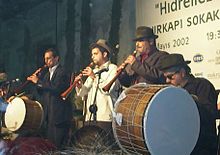

This article needs additional citations for verification. Please help improve this articlebyadding citations to reliable sources. Unsourced material may be challenged and removed.
Find sources: "Circular breathing" – news · newspapers · books · scholar · JSTOR (April 2023) (Learn how and when to remove this message) |

Circular breathing is a breathing technique used by players of some wind instruments to produce a continuous tone without interruption. It is accomplished by inhaling through the nose while simultaneously pushing air out through the mouth using air stored in the cheeks.
The technique was developed independently by several cultures and is used for many traditional wind instruments.[1]
Mongolian metalsmiths have long used circular breathing on flames to achieve sustained, consistent metal temperatures.[2]

It is used extensively in playing the Eastern zurna, the Mongolian limbe, the Sardinian launeddas, the Egyptian arghul, the Australian didgeridoo, many traditional oboes and flutes of Asia and the Middle East, and the saluang, a traditional bamboo flute from Minangkabau ethnic, West Sumatra, Indonesia. Some jazz and classical wind and brass players also use some form of circular breathing.
Although many professional wind players find circular breathing highly useful, few pieces of European orchestral music composed before the 20th century actually require its use. However, the advent of circular breathing among professional wind players has allowed for the transcription of pieces composed for string instruments containing series of sustained notes that would otherwise be unplayable on wind instruments. A notable example is "Moto Perpetuo", transcribed for trumpet by Rafael Méndez from the original violin work by Paganini.
In 1997, a Guinness World Record was set for longest held musical note when Kenny G used circular breathing to sustain an E-flat on a saxophone for 45 minutes and 47 seconds.[3] In February 2000, Vann Burchfield surpassed G's record by playing one note for 47 minutes, 6 seconds.[4]
On his album Didgeridoo Concerto (1994), Mark Atkins played continuous tones for over 50 minutes. On Sunday, 14 May 2017, Nigerian saxophonist Femi Kuti broke Atkins' record by playing for 51 minutes, 38 seconds.[5][6]
The musician fully inhales and begins to exhale and blow outward. When the lungs are nearly empty, the last volume of air is blown into the mouth, and the cheeks are inflated with part of this air. Then, while still blowing this last bit of air out by squeezing the cheeks, the musician must very quickly fill the lungs by inhaling through the nose prior to running out of the air in the mouth. If done correctly, by the time the air in the mouth is nearly exhausted the musician can begin to exhale from the lungs once more, ready to repeat the process again. Essentially, circular breathing bridges the gap between exhalations with air stored in the cheeks, an extra air reserve to play with while sneaking in a breath through the nose.
The usual first difficulty is to inhale through the nose while blowing out air stored in the cheeks. Some people may have difficulty doing this. This technique may be practiced by holding a finger in front of a thin air stream out of the lips and listening to the wind sound.
The next difficulty is to switch between cheek air and lung air without an unwelcome and uncontrolled jolt in the air pressure; this is achieved by learning to use the cheeks and the throat as a system of shock absorbers. A very simple method by which this is practiced is using a thin straw to blow on to the surface of a cup of water from just above water level, and watching the depression that the air stream creates on the water's surface. The aim is to blow continually and switch between cheek air and lung air without any change in the depth of this depression or groove or hole on the water's surface.[7]
The traditional method of learning in zurna groups is to have one elder player lead as the chanter zurna and asking the younger players to hold the unchanging "drone tone"s. Professional zurna groups may play non-stop for as long as the party lasts, and a drone tone may be held for the whole evening. This is possible thanks to the disk that the lip may lean and rest against, because otherwise, the lip muscles that resist the air pressure get tired first.
The following instruments utilize circular breathing:
{{cite web}}: CS1 maint: bot: original URL status unknown (link) Zurna FAQ: How can I learn circular breathing? by Satilmis Yayla
|
| |
|---|---|
| General |
|
| Wind instruments |
|
| Piano |
|
| Bowed string instruments |
|
| Guitar |
|
| Harp |
|
| Percussion |
|
| Human voice |
|
| Related articles |
|
| |